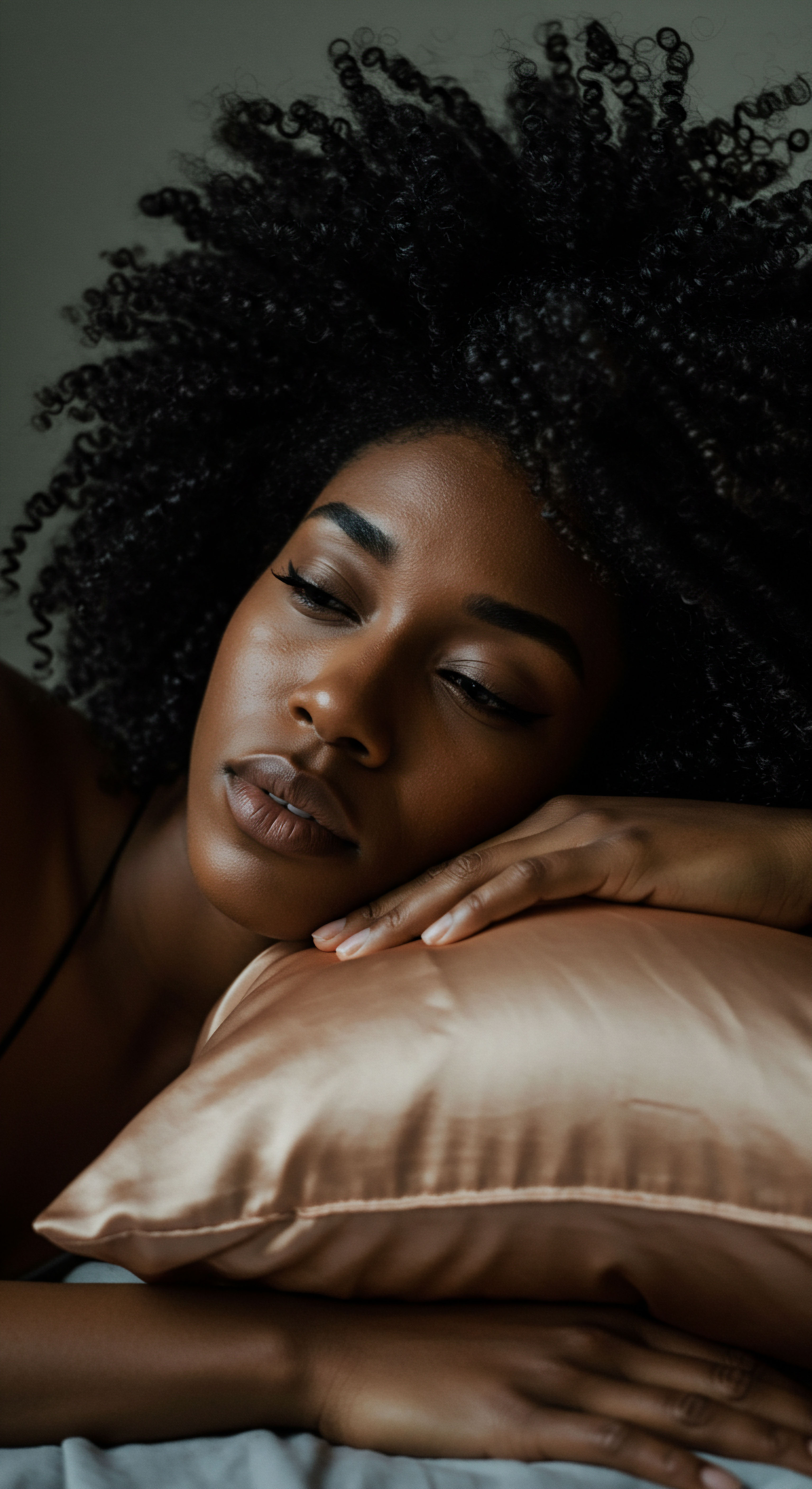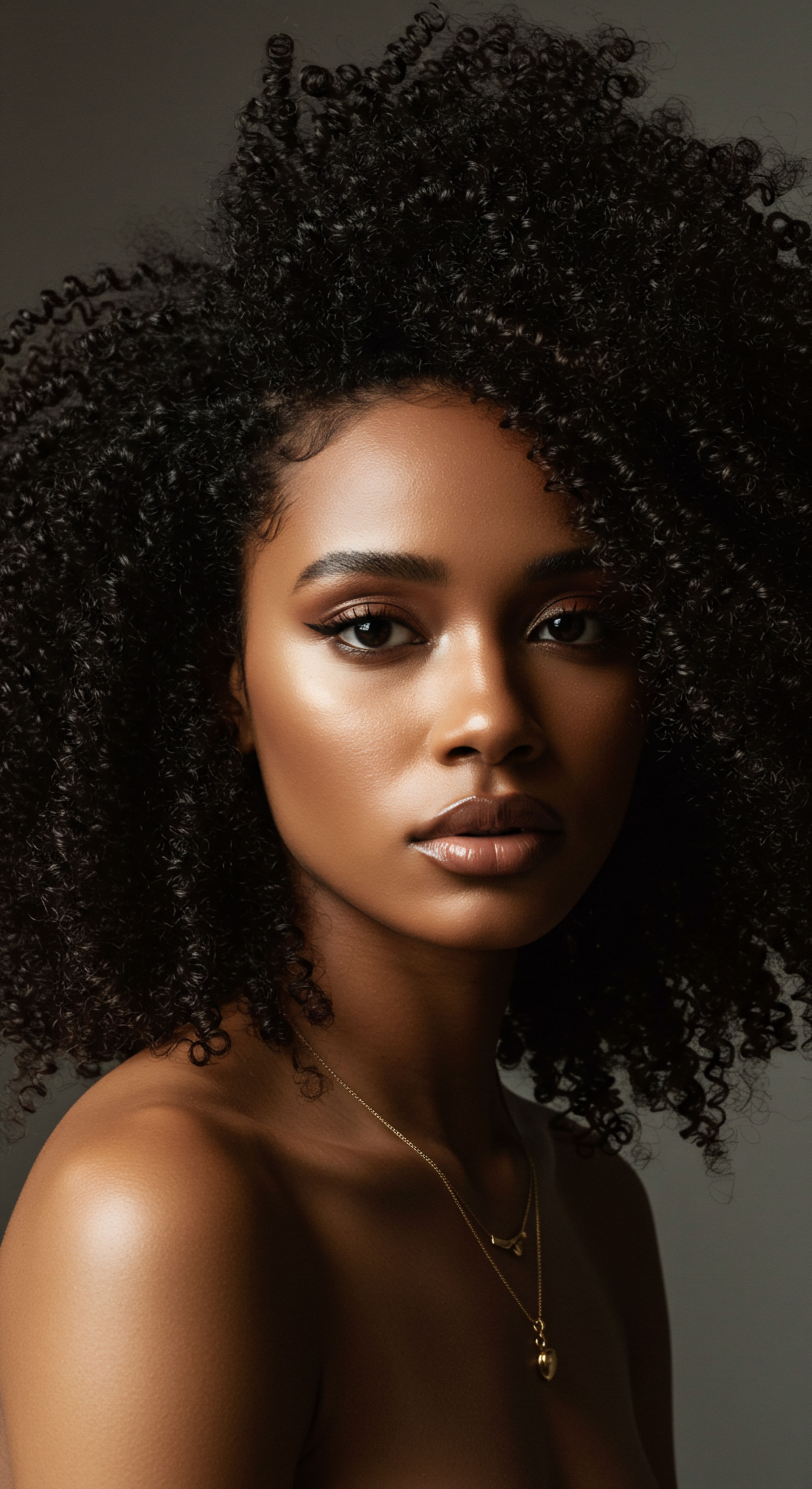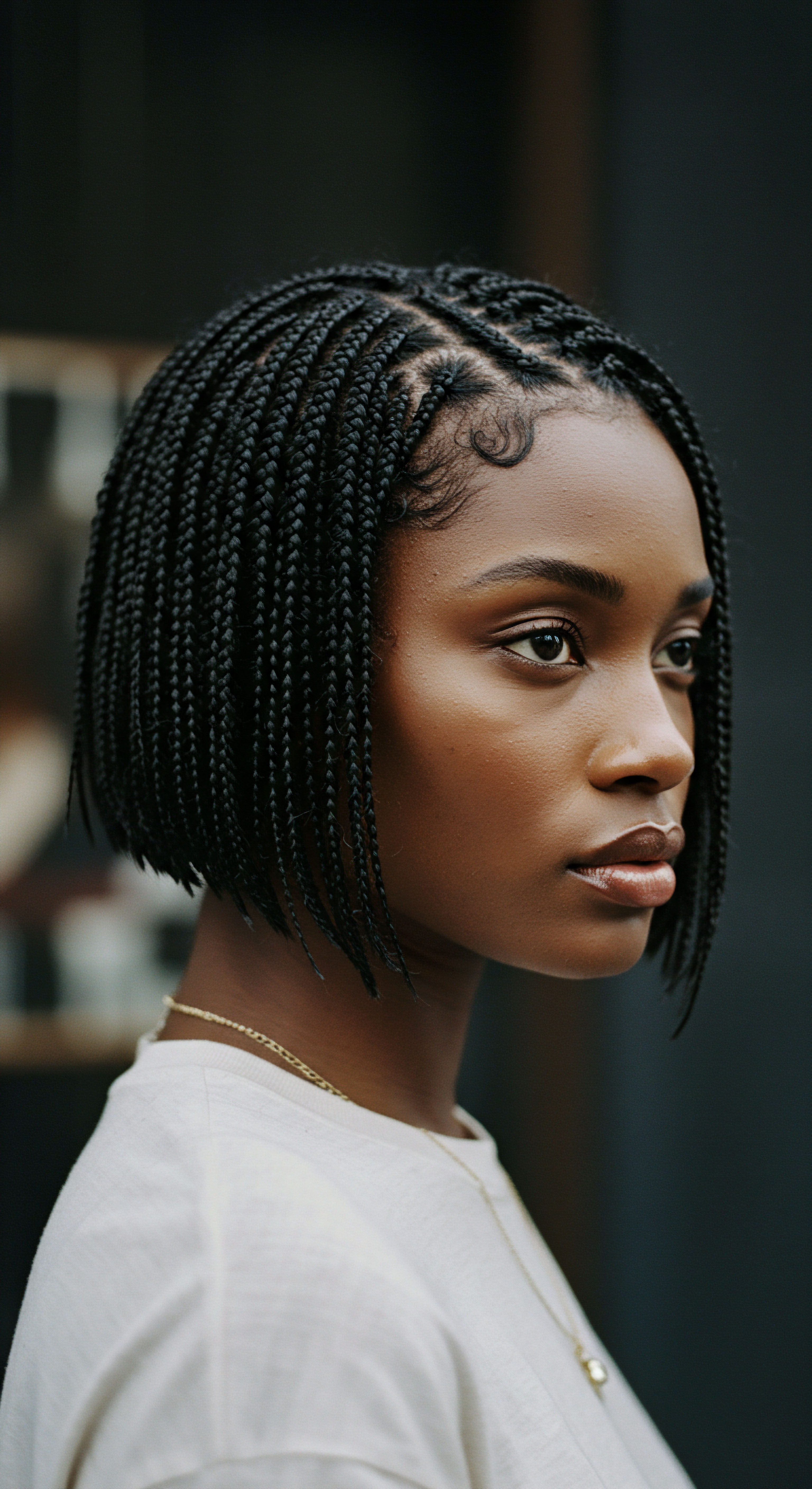
Roots
The quiet rustle of leaves, the gentle sway of branches in a soft breeze—these natural rhythms hold echoes of ancient wisdom, a knowing passed down through generations. Just as the earth nurtures its deepest roots, so too did our ancestors tend to their hair, understanding its connection to vitality, identity, and protection. This care was not a fleeting trend, but a deeply ingrained practice, a silent language spoken through hands, herbs, and heartfelt intention. We consider how these enduring customs laid a foundation for hair health, reaching far beyond mere appearance.

Understanding the Hair’s Structure
The strands that crown our heads are more than simple filaments; they are complex structures, each with its own story. At its core, every hair shaft possesses a medulla, a soft inner layer, encased by the cortex, which provides strength and color. Guarding these inner components is the cuticle, a delicate outer layer of overlapping scales, much like shingles on a roof. This cuticle serves as the primary shield against external aggressors.
When these scales lie flat and smooth, hair appears shiny and resists damage. When disturbed or lifted, however, the inner cortex becomes exposed, leading to dryness and breakage. Ancestral practices, often intuitively, worked to maintain this critical outer defense.
Ancestral hair care was a deeply ingrained practice, a silent language spoken through hands, herbs, and heartfelt intention, protecting hair by honoring its natural design.

What Distinguishes Different Hair Textures?
The diversity of human hair is a marvel, a spectrum of coils, curls, waves, and straight patterns, each with its unique characteristics and requirements. Textured hair, particularly those with tighter curl patterns, possesses an inherent predisposition to dryness and mechanical vulnerability. This is due to the very nature of its helical shape, which makes it more challenging for natural oils produced by the scalp to travel down the entire length of the strand.
Additionally, the bends and twists in coily hair mean the cuticle scales are often not as uniformly laid flat as in straight hair, leading to increased porosity and a greater susceptibility to moisture loss and external damage. Understanding these distinct structural attributes was a quiet, guiding principle for ancestral communities, informing their protective approaches.
- Coily Hair ❉ Often described as Z-patterned or S-patterned, these strands are tightly coiled, making them prone to tangling and dryness due to the difficulty of natural oils distributing evenly.
- Curly Hair ❉ These strands form distinct spirals or loops, which can range from loose waves to tight curls, requiring careful moisture retention to prevent frizz and breakage.
- Wavy Hair ❉ Characterized by gentle S-shapes, wavy hair often falls between straight and curly, benefiting from methods that enhance its natural pattern without weighing it down.

Ancient Wisdom and Material Knowledge
Long before the advent of modern laboratories, communities worldwide held a profound knowledge of their local botanicals and natural resources. They observed the resilience of plants, the nourishing properties of certain oils, and the cleansing abilities of various clays. This observational science, honed over millennia, allowed them to develop hair care systems perfectly suited to their environments and hair types.
From the arid plains where moisturizing butters were paramount, to humid regions where clarifying herbs were essential, each practice was a testament to a deep, reciprocal relationship with the land. These traditional systems understood that true hair vitality stemmed from working in harmony with nature, rather than against it.
Consider the ancient use of plant-based cleansers, often derived from saponin-rich roots or fruits. These gentle cleansing agents, unlike many harsh modern sulfates, cleansed the scalp and hair without stripping away essential moisture. They respected the hair’s natural lipid barrier, which is crucial for maintaining cuticle integrity.
Similarly, the application of various plant oils and butters provided external lubrication and a protective seal, aiding in the prevention of water loss and mechanical friction. These early formulations were not simply about cleanliness; they were about preserving the hair’s inherent protective mechanisms.

Ritual
To step into the world of ancestral hair care is to recognize that daily or periodic practices were not merely chores, but rather intentional ceremonies, each gesture imbued with purpose and quiet care. It is an invitation to consider how these methodical approaches, often performed with gentle hands and thoughtful consideration, shaped the strength and resilience of hair across generations. This section explores the applied wisdom of these customs, delving into the specific techniques and natural materials that offered protection, moving beyond a simple surface understanding to appreciate their deeper practicalities.

The Protective Art of Styling
Many ancestral communities developed sophisticated styling techniques that served a dual purpose ❉ aesthetic expression and hair preservation. Styles such as braids, cornrows, and various forms of threading were not merely decorative; they were ingenious methods of safeguarding the hair shaft from environmental exposure and mechanical damage. By gathering individual strands into larger, cohesive units, these styles reduced friction between hairs, minimized tangling, and protected the delicate ends, which are the oldest and most vulnerable parts of the hair. This deliberate manipulation decreased daily wear and tear, allowing hair to retain length and health over time.
In West Africa, the Yoruba people of Nigeria practiced “Irun Kiko,” a form of hair threading that dates back to the 15th century. This technique involved using flexible wool, cotton, or rubber threads to tie sections of hair, wrapping them into three-dimensional patterns. Beyond its social and spiritual significance, threading offered a simple yet effective way to stretch hair and retain length by protecting it from breakage.
The threaded hair could then be manipulated into various shapes, often adorned with cowrie shells or beads, which conveyed social standing and personal style. This approach highlights a thoughtful design for protection within cultural expression.

Herbal Infusions and Oil Applications
The application of natural oils and herbal infusions formed a cornerstone of protective ancestral hair care. These botanical remedies were chosen for their inherent properties, often observed and tested over centuries. Oils, such as coconut, almond, castor, and argan, provided a lipid layer that coated the hair shaft, reducing water loss and increasing its pliability. This external shield helped to smooth the cuticle, minimizing friction and preventing the ingress of damaging substances.
In Ayurvedic traditions from India, the practice of hair oiling is deeply rooted. Herbal oils, infused with ingredients like amla, bhringraj, and brahmi, were regularly massaged into the scalp and hair. These practices aimed not only to nourish the hair but also to stimulate circulation in the scalp, promoting overall hair vitality. The wisdom behind these infusions extended to their antimicrobial and anti-inflammatory properties, which contributed to a healthy scalp environment, a prerequisite for healthy hair growth.
Regular oiling, often infused with botanicals, formed a protective lipid layer on the hair, smoothing the cuticle and aiding moisture retention.

What Role Did Scalp Health Play in Ancestral Hair Protection?
Ancestral communities understood that healthy hair begins with a healthy scalp. Many traditional rituals focused intensely on the scalp as the source of hair’s vitality. Cleansing agents derived from natural sources, such as saponin-rich plants, were used to gently remove impurities without stripping the scalp’s natural oils. These cleansers maintained a balanced scalp environment, preventing irritation and conditions that could hinder hair growth.
Beyond cleansing, scalp massages with herbal oils were common across many cultures. These massages were not just relaxing; they were believed to stimulate blood flow to the hair follicles, ensuring a steady supply of nutrients necessary for strong growth. For instance, the use of black seed oil, known for its antibacterial, antifungal, anti-inflammatory, and antioxidant properties, was advocated for treating scalp concerns like dandruff and maintaining moisture. This focus on a well-nourished, balanced scalp was a quiet, yet powerful, protective measure.
The emphasis on scalp health also extended to protective accessories. The practice of covering hair at night, often with materials like silk or satin, was a widespread custom. These coverings minimized friction against rough surfaces, preventing tangling and breakage that could otherwise compromise the hair and irritate the scalp. This simple yet profound ritual safeguarded both the delicate hair strands and the foundational health of the scalp, allowing for uninterrupted restoration.

Relay
We now consider the deeper layers of ancestral hair care, where scientific insight, cultural intelligence, and the subtle interplay of various factors converge. This exploration seeks to understand not just the ‘how,’ but the profound ‘why’ behind these enduring practices, revealing a sophisticated, interconnected system of protection. The wisdom of our forebears, often intuitive, often deeply rooted in observation, holds surprising resonance with contemporary scientific understanding, offering a more profound insight into hair’s resilience.

The Science of Structural Integrity and Ancestral Methods
The protective qualities of ancestral rituals extend to the very architecture of the hair strand. Textured hair, with its unique helical structure, presents particular challenges for maintaining cuticle integrity. The natural bends and twists mean the cuticle layers are more exposed and prone to lifting, leading to increased porosity and susceptibility to damage. Ancestral practices, often unknowingly, mitigated these vulnerabilities.
Consider the widespread use of oils. While modern science has illuminated the molecular mechanisms, ancestral communities observed the visible benefits. Research indicates that certain oils, particularly those rich in saturated and monounsaturated fatty acids like coconut oil, possess the ability to penetrate the hair shaft.
This penetration helps to reduce the amount of water absorbed by the hair, thereby lowering hygral fatigue—the repeated swelling and drying that can compromise hair’s strength. By filling gaps between cuticle cells, these oils also form a barrier against external aggressors, including harsh surfactants found in some cleansing agents.
A study published in The International Journal of Trichology investigated oil penetration into hair and its correlation with hair thickness and tensile strength. The researchers found that hair fiber thickness significantly increased when treated with oil, indicating oil penetration into the fiber. They concluded that hair thickness is directly proportional to tensile strength, demonstrating that hair strength directly benefits from oil penetration. This scientific backing provides a contemporary lens through which to appreciate the protective power of ancient oiling traditions.

Do Protective Styles Truly Safeguard Hair From Damage?
Protective styles, such as braiding and threading, have long been lauded for their ability to guard hair from environmental stressors and daily manipulation. Yet, the effectiveness of these styles hinges on their proper execution and maintenance. While they reduce direct exposure and friction, overly tight tension at the scalp can lead to a condition known as traction alopecia, a form of hair loss caused by repetitive pulling.
A study investigating the impact of braiding and combing on the integrity of natural African hair revealed compelling insights. It found that while frequent braiding can cause cuticle damage and weaker hair fibers, leading to higher traction alopecia scores, the impact of combing can be equally, if not more, detrimental. The study showed a linear trend between surface hair fiber damage and the number of combing strokes, concluding that cuticle damage from 480 combing strokes was more severe than that from frequent braiding.
This suggests that the method of daily manipulation, even seemingly innocuous acts like combing, plays a significant role in hair health, underscoring the subtle protective value of styles that minimize such handling. The ancestral preference for long-term, low-manipulation styles thus finds a surprising scientific ally in this observation.

Hair as a Repository of Identity and Well-Being
Beyond the physical protection, ancestral rituals safeguarded hair’s symbolic and psychological significance. For many cultures, hair is a profound expression of identity, spirituality, and social standing. The meticulous care involved in these rituals often served as a grounding practice, a moment of quiet introspection and connection to heritage. This deliberate act of self-care contributed to a sense of well-being, which in turn, positively influenced overall health, including hair vitality.
In various African communities, hair care was a communal activity, a shared experience that strengthened social bonds and transmitted knowledge across generations. The styles themselves often communicated age, marital status, or tribal affiliation. To maintain such a visible and culturally loaded aspect of self required consistent, respectful care. This psychological investment in hair, viewing it as a sacred extension of the self rather than merely a cosmetic accessory, inherently promoted practices that prioritized its health and longevity.
The connection between personal grooming rituals and psychological well-being is increasingly recognized. Studies suggest that self-care practices, including hair grooming, can positively affect self-esteem and mental health. The act of caring for one’s hair can provide a sense of control and mindfulness, creating a respite from daily pressures.
This holistic understanding, where physical care intertwines with emotional and spiritual nourishment, formed an invisible yet potent layer of protection in ancestral hair practices. The consistent, gentle attention fostered by these rituals, driven by cultural reverence, contributed to the physical resilience of hair over a lifetime.
| Ingredient Coconut Oil |
| Origin/Tradition India, Southeast Asia |
| Key Protective Actions Penetrates hair shaft, reduces protein loss, provides moisture, offers antibacterial/antifungal scalp benefits. |
| Ingredient Argan Oil |
| Origin/Tradition Morocco |
| Key Protective Actions Rich in fatty acids and antioxidants, hydrates, restores shine, lightweight, protects from environmental damage. |
| Ingredient Rice Water |
| Origin/Tradition Japan (Yao women), China |
| Key Protective Actions Rich in inositol, repairs damaged hair, protects from future harm, adds strength and luster. |
| Ingredient Chebe Powder |
| Origin/Tradition Chad (Basara tribe) |
| Key Protective Actions Natural blend of indigenous ingredients, aids length retention by filling hair shaft spaces and sealing the cuticle, mixed with moisturizing butters. |
| Ingredient Amla (Indian Gooseberry) |
| Origin/Tradition India (Ayurveda) |
| Key Protective Actions Strengthens hair, promotes growth, maintains healthy scalp, used in herbal oils. |

Reflection
The journey through ancestral hair rituals reveals a profound connection between heritage, self-care, and the enduring vitality of our strands. It speaks to a wisdom that saw hair not as a separate entity, but as an integral part of one’s being, deserving of gentle, purposeful attention. These practices, honed over generations, offer more than historical curiosity; they present a compelling argument for slowing down, listening to our hair’s unique needs, and honoring the deep roots of our identity. Perhaps the greatest protection offered by these traditions is the reminder that true beauty arises from a place of mindful care, respect, and a quiet understanding of what truly nourishes us, inside and out.

References
- Sureka, P. Agrawal, T. Majumder, S. & Ritambhara, K. (2022). A method to measure oil penetration into hair and correlation to tensile strength. International Journal of Trichology, 14(3), 128-134.
- Underwood, M. (2024, April 22). Natural Hair Care Rises as Empowering Self-Care Ritual. Howard University News Service.
- Myers, R. A. & Howell, N. J. (1992). The effect of grooming on the hair cuticle. Journal of Cosmetic Science, 43(2), 101-110.
- Dharajiya, D. A. Jasani, H. I. Khatrani, T. A. Kapuria, M. A. Pachchigar, K. A. & Patel, P. A. (2016). Evaluation of antibacterial and antifungal activity of fenugreek (Trigonella foenum-graecum) extracts. International Journal of Pharmaceutical Sciences and Research, 8(1), 212-217.
- Shetty, V. P. & Shere, S. K. (2019). Hair Cosmetics ❉ An Overview. Indian Journal of Dermatology, 64(2), 102-108.
- Sivakami, T. (2024, June 3). Reviving Ancient Hair Rituals ❉ Exploring the Therapeutic Art of Hair-Oiling. Clinikally.
- Lynch, M. E. & Smith, J. D. (2015). Contemporary African-American Hair Care Practices. Journal of Clinical and Aesthetic Dermatology, 8(5), 28-32.
- Van Paasschen, J. Walker, S. C. Phillips, N. Downing, P. E. & Tipper, S. P. (2015). The effect of personal grooming on self-perceived body image. International Journal of Cosmetic Science, 37(1), 108-115.
- Draelos, Z. D. (2010). Essentials of hair care often neglected ❉ Hair cleansing. International Journal of Trichology, 2(1), 24-29.
- Meyers, M. A. Chen, P. Y. Lin, A. Y. M. & Seki, Y. (2020). On the Strength of Hair across Species. Journal of the Mechanical Behavior of Biomedical Materials, 102, 103507.
- Randhawa, M. & Zage, K. (2019). The Role of Natural Oils in Hair Health. Cosmetics & Toiletries, 134(10), 40-47.